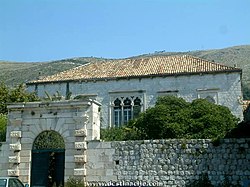Trpanj
| Trpanj | |
|---|---|

The Getaldić-Gundulić house
|
|
| The location of Trpanj within Croatia | |
| Coordinates: 43°0′0″N 17°16′30″E / 43.00000°N 17.27500°ECoordinates: 43°0′0″N 17°16′30″E / 43.00000°N 17.27500°E | |
| Country |
|
| County |
|
| Population (2001) | |
| • Total | 871 |
| Time zone | CET (UTC+1) |
| • Summer (DST) | CEST (UTC+2) |
| Postal code | 20 240 |
| Area code(s) | 020 |
| Licence plate | DU |
| Website | trpanj.hr |
Trpanj (Italian: Trappano), is a town and municipality of Dubrovnik-Neretva County in south-eastern Croatia. According to the 2001 census, Trpanj has a population of 871. Croats make up 93.11% of the population.
There is more than one theory about the origin of the name Trpanj. According to one, the name was derived from the Croatian verb trpjeti, meaning "to suffer." Another theory draws the origin of the name from an Ancient Greek word for sickle, which is the shape formed by the cliffs surrounding the town's harbor. According to a third theory, the name was derived from the name of the ancient fortification called Tarpano or Tarponio, the remains of which can still be seen on the hill overlooking the harbor. Finally, the sea cucumber is called a "trp" in Croatian, leading some to make the connection.
The area has been inhabited since ancient times. Examples of prehistoric pottery, evidence that the site may have been inhabited by an urban-type society, were found on the slopes of Gradina, the small hill overlooking the port. Other traces of prehistoric humans were found on the St. Roko hill. Life in the area may not have been easy as it is located between barren cliffs to the north and the Miloševica, Viter and Prvač Dol hills to the south.
The first traces of Roman occupation were discovered in 1922, when a mosaic was uncovered in a park under the Gradina hill. In 1963, walls of a Roman “villa rustica” were found, as well as a base of a Roman column and an inscription from the 2nd or 3rd century AD. When the Romans occupied the area they encountered Illyrians, who were dwelling on the slopes of Gradina. According to the Dubrovnik historian Jakov Lukarić, the ancient fortress, Tarpano or Tarponio, was destroyed by Julius Caesar while he was fighting the Illyrians. As a result, the old inhabitants of Trpanj took the three towers as the town emblem. Other evidence of Roman presence was covered over the centuries by a thick layer of soil carried over the centuries by the Potok brook.
...
Wikipedia

